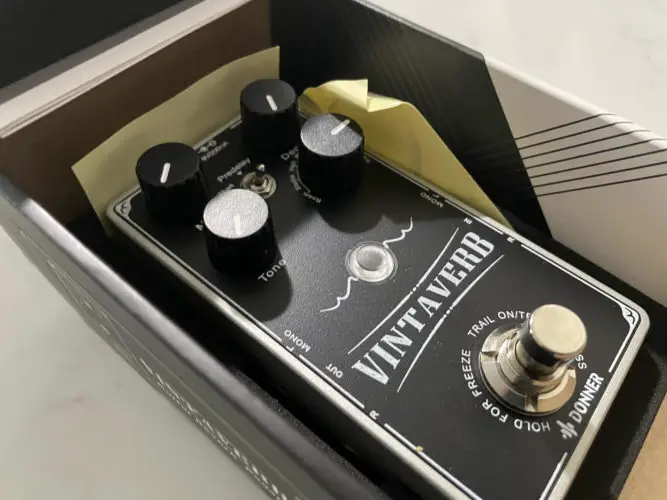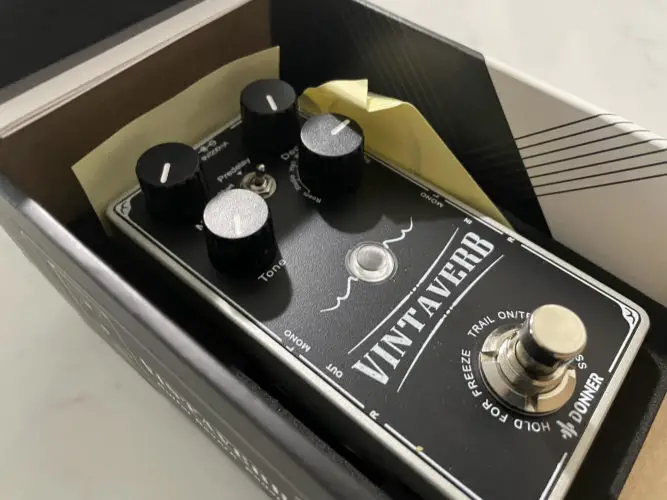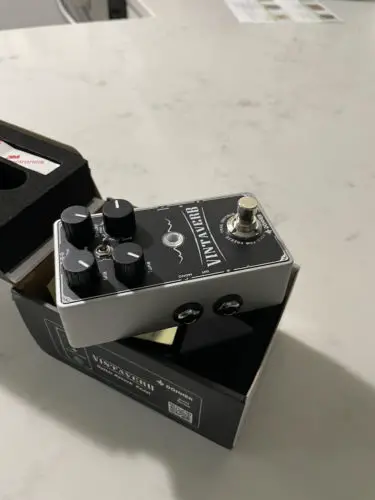Today, we look into one of Donner’s guitar pedals, the Vintaverb.
While using an effect pedal is not necessary to make great music, it can help you reach new levels without all the hassle.
It’s one of those things that can make your life much easier, as long as you know when and how to use it.
After quite a bit of testing, I found that the Donner Vintaverb ambitiously tries to cover large grounds by offering seven reverb modes. Some of those effects were a hit, while others, not so much. However, its affordability makes up for the little compromises here and there.
In this review, we go over what makes the Vintaverb unique and whether or not it’s worth your money. As a bonus, we also see how it compares to some of its alternatives in the market.
There’s just so much info to dig into, so let’s jump right in!
Donner Vintaverb Overview
The Vintaverb is a multi-type digital stereo guitars pedal from the Donner company. It’s an effect unit that alters the signal from a guitar or reroutes it to enhance the audio complexity on demand.
While you can set up your guitar directly to an amplifier, using the pedal gets you closer to the exact tones you need. It can give your music dimension in ways beyond the amp’s scope. Some people might even need more than one pedal in their setup.
Is the Donner Vintaverb Any Good?
The main appeal of the Vintaverb is its seven modes of world-class reverb. This includes room, studio, hall, plate, spring, modulation, and distortion. Most importantly, it’s one of the most affordable guitar pedals out there that does stereo hold/freeze.
When it comes to plate, distortion reverb, or hall, the Vintaverb doesn’t disappoint.
Donner Vintaverb Specifications
Before we dig deeper into our Vintaverb review, let’s first take a look at the basic specs covered by the pedal:
- 7 Reverb modes
- ¼” mono audio jack
- 150mA current draw
- AC adapter 9V DC power supply negative in the center at 200mA
- Pre-delay switch with 20ms/40ms
- Mix knob to control the balance of effect to dry signal
- Tone knob to adjust signal brightness
- Decay knob to control the reverb length
- Switchable true bypass buffer (Trail ON mode)
- Freeze mode switch to sustain reverb
Features to Love About the Donner Vintaverb
Moving on, we’ll objectively consider some of the top features of the Vintageverb pedal:
Neat Interface/Parameter Controls
One of the things that are attractive about the Vintaverb is how easy and down-to-earth it makes controlling several parameters.
You’ll have to get familiar with the layout, though.
The Vintaverb is a full-size black and silver robust metal pedal that’s 4.45 x 2.48 x 2.13 inches. On the top side, there are four knobs, a center switch, and a button.
The top right knob is responsible for decay control. The top left is for mixing the dry signal in. The bottom left for tone filter adjustment. Meanwhile, the bottom right knob has all seven reverb modes.
It would have been nice to see separate controls for the bass and treble as opposed to a single filter tune. This would add transparency instead of the subtractive darkening and brightening approach in most EQs.
Sadly, the Vintaverb is missing this function. However, Donner does offer it in the Dark Horizon overdrive.
In between all of those four knobs, you’ll see the pre-delay switch, with two settings from short to long. The short one is 20ms, while the long one is 40ms.
At the bottom of the pedal, there’s a huge silver button. This works mainly as a Train ON switch, but if you press and hold it for a while, you activate the freeze.
To keep track of your freeze presses, you can check the light indicator right above the Vintaverb logo.
Overall, Donner hit the nail on the head with the right size, positioning, and resistance for each control.
Just keep in mind that this is all just about appearances. The performance is a whole different story!
Balanced Audio Performance
We’ve covered that the Vintaverb provides control over a relatively wide range of parameters. Now, let’s see how this translates practically.
When it comes to performance, it all comes down to a single phrase: usable with a few compromises.
Most of the compromises are minor and could easily go unnoticed by an untrained ear. The reverb algorithms are definitely not on par with a high-end pedal, but they’re surprisingly good for this price point.
Meanwhile, the plate, hall, and stereo algorithms were surprisingly pleasant. They all had a kick that was missing in the room and hall reverbs. The plate, in particular, sounds superb with low decay around 10 O’clock knob placement.
Keep in mind that even the celebrated Donner Dumbal Drive didn’t have stereo reverb. So, that’s a huge bonus point for the Vintaverb if you’re doing a head-to-head comparison!
If you use the DSVerb, you get a combo of distortion and reverb, which is great for creating freezing textures. It’s a solid option for a synth setup, too.
Yet, the modulated reverb algorithm is the bee’s knees! It’s rich, ethereal, and absolutely captivating.
With that said, turning the tone filter knob all the way to the right will almost erase the reverb entirely. Fully open effects can resonate slightly, especially at higher decay. That’s less than ideal, but it’s not a deal-breaker.
Additive Freeze
The freeze function deserves a discussion on its own. After all, no one expects to see this feature on a pedal at this price.
We were even more surprised to see that the freeze maintains the stereo image all the way through.
Just keep in mind that the algorithm has a bit of a feedback loop integrated into it. This means that the signal can swell or build on itself without you intentionally causing this additive effect.
The signal coming out of the freeze can feel around 2-3dB louder than the input, and it doesn’t seem adjustable so far.
Don’t get us wrong, though. The freeze being additive isn’t really a pro or a con in itself.
For some people, it can be a huge plus, while others could find it mildly annoying. It’s just one of those things that you’ll have to get used to.
If it all works out well, after a while, you’ll be able to use it lightly and work out the fine-tuning according to your taste.
It’s also worth noting that the attack function can slow down the high gain signals. So, it might be better to leave it moderately low when you’re aiming for a cleaner sound. Generally, the threshold will cut out everything after the knob’s 3 O’clock position.
Optional Rubber Feet Attachment
When you have a complex pedaling setup, figuring out the logistics of it all can be a bit tricky. Some people use a board to adjust the layout.
This would usually mean getting velcro mounting tape to keep the pedal in place. Other guitarists buy brackets to screw the equipment to the metal pedalboard.
Thankfully, Donner provides the Vintaverb guitar reverb with a removable rubber feet attachment.
You can keep the pedal propped on the rubber feet if you want to use it as a standalone piece without any holding boards.
If you want to integrate it with a setup, just unscrew the removable feet and hang it as you would normally.
It might seem like such an insignificant little thing, but it makes the pedal more convenient. Giving the user room for customization is always a huge plus!
True Bypass/Trail ON Mode
Building on the customization potential, Donner added a true bypass feature to the Vintaverb pedal.
When the pedal is set on bypass mode, the incoming signal is directed to the amplifier. It’s released without any interference in tone coloration or frequency changes.
The way this rerouting usually works is by incorporating a DPDT switch, which stands for Double Pole and Double Throw. In essence, it allows the input signal to pass cleanly through a secondary circuit.
However, this can be a double-edged sword.
It’s a great feature to have for guitarists with complex setup chains. It boosts the pedalboard flexibility without having to buy a separate buffer.
On the other hand, a few hiccups pop up with true bypass. For instance, you might experience switching noises, especially in long chains of more than four pedals.
That’s why a lot of affordable options opt out of the whole true bypass racket.
Whenever you want to double-check that a pedal has a true bypass or not, turn off the power supply first. Then, see if the guitar signal still manages to make it through the chain to the amplifier.
The Donner Warranty Policy
Besides the typical 30-day return policy, Donner covers its products with a warranty policy.
The range of coverage depends on the tool itself, but most items have at least one-year warranties.
You can also opt for an extended plan of 3-4 years. You’ll have to pay extra for that with the purchase, though.
Although the pedal is already affordable, having the extra layer of protection can take some stress off of your shoulders.
Keep in mind the warranty policy doesn’t cover accidents and negligent use. Any alteration or modification to the pedal will also void the coverage.
Donner Vintaverb Alternatives
Getting to know what your ideal musical setup looks like takes quite a bit of trial and error over the years.
If there’s one lesson to learn here, it’s that there’s hardly a single universal tool that works for everyone. When it comes to music equipment, you can throw away the one-size-fits-all narrative.
Guitar effect pedals are no exception to the rule. Depending on your preferences and budget, you can find suitable alternatives.
Let’s take a look at a few options to consider:
Sonicake Mini Pedal
While the Sonicake pedal is even more budget-friendly than the Vintaverb, it’s compact in size and performance. It offers three reverb modes (room, hall, and plate) only, and it’s all controlled by a single knob and one switch. Needless to mention, it doesn’t have a freeze feature.
Walrus Slö Multi-Texture Pedal
The Walrus Slö pedal is a tad bit more complex than the Vintaverb. The reverb algorithms are mainly controlled by a switch, not a knob. As the design implies, the sounds you get from the Slö are heavily modulated and sleepy.
Electro Harmonix Oceans 11 Pedal
The Electro Harmonix Oceans 11 pedal is one of the most reputable effect pedals out there. It has a significantly wider range of parameters and reverb presets to choose from. However, this pedal is, by no means, as affordable as the Vintaverb.
Flamma FS02 Stereo Pedal
From all the alternatives here, the Flamma FS02 is perhaps the closest to the Vintaverb. They both have seven reverb modes, stereo, true bypass, and train On function. Plus, their price tags are in the same range.
Final Thoughts
The Vintaverb might never end up being your go-to for spring reverb, but it’ll still bring a lot to the table (or the pedalboard, so to speak.)
Other aspects are really up to your preference, like the additive freeze or the true bypass. They might hit the mark or be slight compromises.
In the end, the Donner Vintaverb is a very decent performer for its cost, and we can’t really take that away from it. Check out more details on Amazon.



